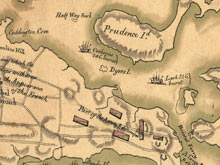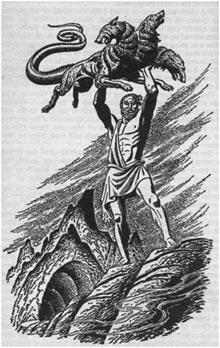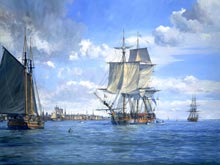
This John Mecray painting, The Continental Sloop Providence Captain John Paul Jones — June 13, 1776, depicts the British frigate Cerberus engaged in a skirmish with an American sloop. Click image for larger view and image credit.
The HMS Cerberus was named for the three-headed dog with a snake's tail that guarded the gates to hell in Greek mythology. Click image for larger view and image credit.
The HMS Active, shown here in Boston Harbor, was the sister ship of HMS Cerberus. Both vessels were in the Coventry class of frigates. Click image for larger view and image credit.
The History of the HMS Cerberus and HMS Lark
D.K. (Kathy) Abbass
Director and Founder
Rhode Island Marine Archaeology Project
Rod Mather
Associate Professor of Maritime History and Underwater Archaeology
University of Rhode Island
The British frigates HMS Cerberus and HMS Lark were among the more than 20 vessels that were burned or sunk — or both — in Rhode Island during the Revolutionary War. The two ships, especially Cerberus, participated in key battles in the Revolutionary War; the Cerberus also participated in the French and Indian War. Later, the Cerberus came close to her demise when she was targeted by perhaps the first underwater explosive mine, and the Lark inadvertently brought smallpox to Newport, Rhode Island. In addition to their storied histories, both ships were very early versions of an important British vessel. For this reason, they can provide valuable insights about their architecture.
Both ships were wrecked by their captains in August 1778 to avoid capture by the French, who had joined the American war effort. The remains of these frigates were not discovered until in the 1970s — and given their explosive endings, there may be much more to find.
HMS Cerberus: Early History
The Cerberus was involved in numerous events (and people) of historical significance, most occurring in North America. At the commencement of the British attack on Quebec (1758 to 1759), a pivotal event during the French and Indian War (1754 to 1763), Cerberus brought General James Wolfe, the commander of British forces, across the Atlantic to Quebec. The British attack was successful and Quebec fell under British control, but Wolfe was killed in action. The Cerberus then transported the deceased general’s body back to England. Between the end of the French and Indian War and the beginning of the Revolutionary War, the Cerberus made a number of trans-Atlantic voyages.
Cerberus also played a meaningful role in the War for American Independence. Dropping anchor in Boston Harbor on May 25, 1775, Cerberus became the first British warship to arrive in the North America, following the outbreak of American revolutionary hostilities. Her captain, John Chads, brought not only the Parliamentary Acts, which increased tension between the Americans and the British, but also three important generals — William Howe, Henry Clinton, and John Burgoyne. These figures would help mastermind Britain’s war effort. The local press, playing on the origin of the name Cerberus – the three-headed dog with a snake’s tail that guarded the gates to hell in Greek mythology – printed the following:
Behold the Cerberus the Atlantic plough,
Her precious cargo, Burgoyne, Clinton, Howe.
Bow, wow, wow!
Within three days of her arrival, the Cerberus was called into action. She played a crucial role in the first amphibious assault of the war, the so-called Battle of Noddle’s Island. Then on June 17 and 18, British warships, including Cerberus, supported General Howe’s attack on rebel entrenchments on Breed's Hill and Bunker Hill. On June 27, the Cerberus set sail for England. Her captain, John Chads, carried correspondence and news of the worsening situation in America and the hard-fought British victory at the Battle of Bunker Hill.
Towards the end of 1775, George III authorized his commanders in North America to adopt a more aggressive strategy. Under new commander John Symonds, the Cerberus and four other warships followed orders to “lay waste, burn and destroy” rebellious seaport towns of New England, and they harassed the village of Falmouth, Maine. The fearful population called on General George Washington for assistance, but within a few days the British warships set sail for southern New England waters. News of the attacks and harassment of Falmouth spread, strengthening the resolve of rebellious colonists to resist British imperial rule.
In December 1775, the Continental Congress requisitioned several armed merchantmen and created a navy. The appointed commander in chief was a Rhode Islander named Esek Hopkins, who from his base at the northern end of Narragansett Bay, harassed British ships and shipping efforts. Outside the bay and at the entrance to Long Island Sound, Cerberus took up station, protecting British shipping and attacking rebel warships. In April 1776, the Cerberus was off Block Island, where she captured many American vessels suspected of illegal activities.
In June 1776, the Cerberus sparred with armed rebel vessels, including the Rhode Island-based sloop Providence, which at that time was commanded by John Paul Jones, the famous American Revolutionary War hero. The Providence was protecting the sloop Fly, which was transporting cannons to General Washington in New York.
In December 1776, Cerberus was part of the British expeditionary force that, under General Henry Clinton and Commodore William Hotham, occupied Newport, Rhode Island. In the coming months, the Cerberus would also patrol Long Island Sound and anchor near New London, Connecticut.
In August 1777, David Bushnell, an American patriot and pioneer in undersea warfare (who also developed the first successful submarine, the Turtle), saw the Cerberus’ Connecticut anchoring as an opportunity. Bushnell targeted the Cerberus with one of the world’s earliest underwater explosive mines. The planned method of attack was to send the two floating barrels, loaded with explosive and connected by a line, on the prevailing currents in such a way that the line between them snagged the Cerberus. The barrels would then swing around and touch the hull, and a wheel mechanism on the barrel’s side would detonate the explosives.
The attack on Cerberus, however, was only partially successful. On the morning of August 14, 1777, four crew members on board a schooner tied behind Cerberus noticed what appeared to be fishing line. As they pulled it in, they noticed a barrel. As they hauled the barrel on board to examine their good fortune, it exploded, killing three men and wounding a fourth. Cerberus’ captain, John Symonds, recorded one of the earliest instances in mine warfare in his log and reported it to his superiors.
HMS Lark: Early History
In early 1776, the Lark was fitted out and sheathed in preparation for service in America. In July, the Lark convoyed provisions and payroll for British troops from Cork, Ireland, to Halifax, Nova Scotia. During one voyage, the Lark took American revolutionary Ethan Allen onboard to return him to the colonies.
After a short stay at New York, the Lark replaced the Cerberus at Block Island. The Lark cruised between Halifax and New York, and returned to Rhode Island in February of 1777. Stationed off Arnold's Point on the northwestern coast of Aquidneck Island, the Lark was the first to challenge and engage Rhode Island vessels as they tried to escape through the Bristol Ferry narrows into Mount Hope Bay. The Lark also served as the go-between for the small British ships that carried messages, goods for prisoners on both sides, and prisoners for exchange.
On occasion, the Lark would cruise the waters off Rhode Island, and in November 1777, she returned from Boston Bay to Rhode Island with a "stowaway": smallpox. The Lark was hauled inside Goat Island,where her crew was put ashore, her ballast removed, and her interior washed with vinegar and fumigated with tobacco or gunpowder smoke. Despite these precautions, the disease spread among the citizens of Newport.
In 1778, the Lark was stationed in the West Passage to stop ships as they raced for the open sea. In March of that year, she engaged the Continental frigate Columbus; and in May she challenged the Continental frigate Providence (not to be confused with the sloop Providence). The Providence escaped, but the Columbus was run ashore and set afire — the same end the Lark and her sister British frigates would soon suffer.

This chart shows the location of the sunken British frigates Cerberus and Lark. It was drawn by a French engineer named Fage, shortly after the scuttling. The wrecks were precisely located in the 1970s by a University of Rhode Island graduate student. Click image for larger view and image credit.
HMS Lark and HMS Cerberus: The Final Days
In March 1778, Louis XVI of France recognized the United States of America and entered the war as an ally of the new nation. The entrance of France permanently changed the character of the war. No longer a simply a colonial rebellion, it was now part of a broader European conflict.
A powerful French fleet, under the command of Admiral Comte d’Estaing, arrived at the mouth of Narragansett Bay on July 29, 1778, to aid the American revolutionaries. Over the next week, with the French ships anchored in the bay’s west passage, the French and their new American allies planned an attack on the British in Newport.
The Lark and Cerberus, and two other frigates, the Orpheus and the Juno, were among the four British frigates stationed in the bay's east passage. British commanders ordered their frigates in the east passage to unload their vessels along the Aquidneck Island shore, and shortly thereafter, ordered them to reload and sail for Newport, where they would again unload. A day later, they were sent back to Aquidneck Island.
Early on the morning of August 5, the British frigates were once again ordered to return to Newport. As they made their way south for the second time, the two large French war ships stationed in the bay's west passage sailed to intercept them. These 64- and 74-gun ships out-classed the much smaller British frigates.
Remembering his commander’s order that he must not allow the capture of his ship, Captain Symonds ran the Cerberus aground, sending his crew ashore and then setting her afire. The Lark’s Captain Smith also ran his ship aground and set her on fire, as did the captains of the Orpheus and Juno. A short time later, the Lark's 76 barrels of gunpowder exploded, burning a nearby house and rocketing debris as far as three miles inland. Reflecting on the incidents, British engineer Frederick Mackenzie wrote in his diary: "It was a most mortifying sight to us, who were Spectators of this conflagration, to see so many fine Frigates destroyed in so short a time, without any loss on the part of the Enemy."
Immediately following the vessels' loss, American forces may have salvaged some portion of the vessels' armament. Following these salvage efforts, the Cerberus lay undisturbed for almost 200 years. While it is not known how much of each frigate was removed in the early days, there was enough remaining in the 1970s for a graduate student at the University of Rhode Island to locate bits of the Lark, Orpheus, and Cerberus. Even now, little has been found at the sites, besides a few cannons and cannonballs and some small artifacts. However, the full extent of these sites is unknown, as the remains of the ship are buried in silt and scattered over a large area.
Both the Lark, which was found first, and the Cerberus are listed on the National Register of Historic Places. The sites are protected from vandalism and the illegal removal of artifacts by federal preservation laws. The Orpheus and Juno (were she to be found) are also eligible for such National Register listings and are protected by the same laws.
Since 1995, these ships have been the subject of intermittent studies by the Rhode Island Marine Archaeology Project (RIMAP), which trains volunteers to participate in local shipwreck research under the direction of professional archaeologists. The Naval Undersea Warfare Center (NUWC) engineering and diving support team and the Navy's Mobile Diving and Salvage Unit team have been RIMAP's partners in the study of these British frigates.Architectural Details
The Cerberus is one of the earliest true frigates. The techniques used in its construction and the configuration of the hull and vessel’s lines are of the utmost importance to the history of naval architecture. Although the term “frigate” had been used for some time as a generic description of a small fast warship, a specific class of vessel called frigate was not introduced until 1747 to 1748. The captured French privateer, the Tyger, represents the origin of the design of the British Royal Navy’s new class of warships. The first British true frigates, however, were the Lyme and Unicorn. The design of Cerberus, built in 1756, was a slightly modified version of the Lyme and Unicorn.
Details about the size and specifications of both the Cerberus and Lark are known from careful records kept by the British Royal Navy. Cerberus was a Coventry class, sixth-rate, 28-gun British frigate, built by Fen at the Cowes yard and launched in 1758. Her tonnage was 586 76/94; and she measured 118 feet 4 inches (length on lower deck); 97 feet 3 1/2 inches (length of keel for tonnage); 33 feet 8 inches (in breadth at the broadest part of the midship's section); and 10 feet 6 inches (depth in hold). She carried a crew of 200 and was armed with 24 nine-pounders on the upper deck, four three-pounders on the quarter deck, and twelve swivels.
The HMS Lark was a Richmond class, fifth-rate, 32-gun British Royal Navy frigate. She was built at the Rotherhithe yard by Bird and was launched in 1762. The Lark 's tonnage was 646 12/94; and she measured 127 feet (length on lower deck); 105 feet 1 inch (length of keel for tonnage), 34 feet (in breadth at the broadest part of the midship's section), and 11 feet 9 inches (depth in hold). She was larger than the Cerberus, carried a crew of 220, and was armed with 26 12-pounders on the upper deck, four 6-pounders on the quarter deck, and 12 swivels.
Sign up for the Ocean Explorer E-mail Update List.

















